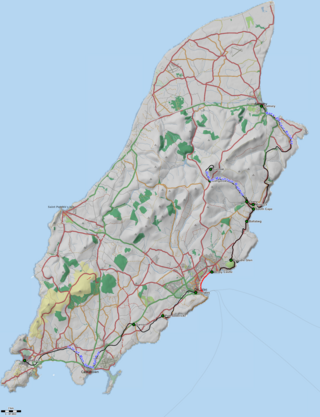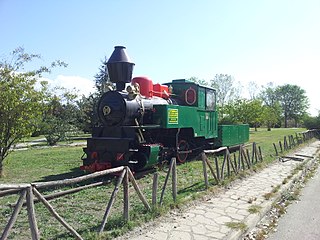Related Research Articles

The Channel Islands are an archipelago in the English Channel, off the French coast of Normandy. They are divided into two Crown Dependencies: the Bailiwick of Jersey, which is the largest of the islands; and the Bailiwick of Guernsey, consisting of Guernsey, Alderney, Sark, Herm and some smaller islands. Historically, they are the remnants of the Duchy of Normandy. Although they are not part of the United Kingdom, the UK is responsible for the defence and international relations of the islands as it is for the other Crown Dependency, the Isle of Man, and the British Overseas Territories. The Crown Dependencies are neither members of the Commonwealth of Nations, nor part of the European Union. They have a total population of about 171,916, and the bailiwicks' capitals, Saint Helier and Saint Peter Port, have populations of 33,500 and 18,207 respectively.

A narrow-gauge railway is a railway with a track gauge narrower than 1,435 mmstandard gauge. Most narrow-gauge railways are between 600 mm and 1,067 mm.

The Alderney Railway on Alderney is the only railway in the Bailiwick of Guernsey, and the only working railway in the Channel Islands. The Alderney Railway opened in 1847 and runs for about 2 miles (3.2 km), mostly following a coastal route, from Braye Road to Mannez Quarry and Lighthouse.

The Fairbourne Railway is a 12+1⁄4 in gauge miniature railway running for 2 miles (3.2 km) from the village of Fairbourne on the Mid-Wales coast, alongside the beach to the end of a peninsula at Barmouth Ferry railway station, where there is a connection with the Barmouth Ferry across the Mawddach estuary to the seaside resort of Barmouth.

The majority of Indonesia's railways are on Java, used for both passenger and freight transport. There are three noncontinuous railway networks in Sumatra while two new networks are being developed in Kalimantan and Sulawesi. Indonesia has finalized its plan for a national railway network recently. According to the plan, 3,200 km of train tracks that will criss-cross the islands of Sumatra, Java, Kalimantan, and Sulawesi, it has been touted as the most extensive railway project in Indonesia since its independence from the Dutch in 1945. Indonesia targets to extend the national railway network to 10,524 kilometres by 2030. As of September 2022, the network spans 7,032 km.

The Isle of Man has a rich transport heritage and boasts the largest narrow-gauge railway network in the British Isles with several historic railways and tramways still in operation. These operate largely to what is known as "Manx Standard Gauge" and together they comprise about 65 miles (105 km) of Victorian railways and tramways. The Isle of Man Railway Museum in Port Erin allows people to find out more about the history of the Manx railways, and was until 1998 accompanied by a similar museum in Ramsey, which was dedicated to the history of the electric line, but this was closed and converted into a youth club. The steam railway to the south of the island, electric to the north and mountain line to the summit of Snaefell, the island's only mountain, are all government-owned, and operated under the title Isle of Man Railways, as a division of the island's Department of Infrastructure. The lines at Groudle Glen and Curraghs Wildlife Park are both privately owned but open to the public.

The National Railway Museum, Port Adelaide, South Australia is the largest railway museum in Australia. More than 100 major exhibits, mainly from the South Australian Railways (SAR) and Commonwealth Railways and their successor, Australian National, are displayed at its 3.5 hectares site. A very large archival collection of photographs of those railways and records created by them is also managed by the museum. The museum is operated with a large number of volunteers.
Rail transport in Fiji moves cut sugar cane to crushing mills. Also, there used to be two horse-drawn street tramway systems, some other passenger systems, an underground mine system, and some tramways on construction projects. There are multiple other modes of transport in Fiji.
Guernsey is the second largest of the Channel Islands. It is part of the Common Travel Area, allowing passport-free travel to and from the United Kingdom, Jersey, the Isle of Man or the Republic of Ireland. Travel to the Schengen Area of Europe requires a passport or an EU national identity document and from 2025 entry to the Schengen Area will require compliance with the European Travel Information and Authorisation System (ETIAS) and non EU citizens may need a visa. Entry from the Schengen Area requires a passport, except when a concession is in place for short trips to Guernsey, when an EU ID card is acceptable.

The Guernsey Railway opened as the Guernsey Steam Tramway on 6 June 1879 with two steam tram engines, more being added later. It was later converted to an electric tramway, which began working on 20 February 1892. The system closed on 9 June 1934. This leaves Alderney as the only Channel Island with a working railway.

There are currently no functioning railways in Haiti, and there have never been any rail connections with the neighbouring Dominican Republic. However, between 1876 and the 1970s, various tramways and railways ran in the country. A tram network operated in the capital, Port-au-Prince, between 1897 and 1932. Three railway lines, along with some industrial lines, constituted the Haitian national rail network. The first horse drawn street tramway opened in 1876, with rural railways constructed later.

A number of private industrial railway lines were constructed in Greece for exclusive use by major mining operations and by extensive industrial facilities. There were also a few temporary lines, used for the construction of major public works. Most of them were either metre gauge or 600 mm narrow gauge.

The first railway in Austria was the narrow-gauge line from Gmunden in the Salzkammergut to Budweis, now in the Czech Republic, this was 1,106 mm gauge. Some two dozen lines were built in 760 mm gauge, a few in 1,000 mmmetre gauge gauge. The first was the Steyrtalbahn. Others were built by provincial governments, some lines are still in common carrier use and a number of others are preservation projects. The tramway network in Innsbruck is also metre gauge; in Linz the rather unusual gauge of 900 mm is in use.
A number of narrow-gauge lines survive, largely as a consequence of German reunification, in the former East Germany where some of them form part of the public transport system as active commercial carriers. Most extensive of those still employing steam traction is the Harz mountain group of metre-gauge lines, the Harzer Schmalspurbahnen. Other notable lines are the Zittau–Oybin–Jonsdorf line in Saxony, the Mollibahn and the Rügensche Kleinbahn on the Isle of Rügen on the Baltic coast and the Radebeul-Radeburg line, Weisseritztalbahn in the suburbs of Dresden. Although most rely on the tourist trade, in some areas they provide significant employment as steam traction is particularly labour-intensive.
Between 1917 and 1930 approximately 300 km of military and industrial narrow-gauge railways were built at the gauge of 600 mm and 750 mm or Bosnian gauge, built by Austria-Hungarians and Italians, intending to create a through route from Skopje and Tetovo to the Adriatic coast of Albania. None of these railways remained intact.

Trams in Linz is a network of tramways forming the backbone of the urban public transport system in Linz, which is the capital city of the federal state of Upper Austria in Austria.
Europe inherited a diversity of rail gauges. Extensive narrow-gauge railway networks exist in Spain, Central Europe and Southeastern Europe.

900 mm narrow-gauge railways are generally found in Europe. This gauge is mostly used for light urban rail networks, industrial and agricultural railways.

The Whangarei Steam and Model Railway Club Inc. was formed in 1978 for the purpose of acquiring, preserving, and operating vintage steam and diesel trains for the education and enjoyment of club members and the general public, the railway operates on Museum Live Days and special occasions over its own 0.8-kilometer (0.50 mi) main track. The club has in its care two Peckett steam locomotives, a Union Foundry, one Bagnall diesel loco, a Drewry and a Price diesel shunters.

The Borkumer Kleinbahn is a 900 mm narrow gauge railway on the German island of Borkum in the North Sea. It is the oldest island railway in Germany, beginning operation in 1888.
References
- ↑ "Unknown". The Railway Magazine. September 1934.
- ↑ "Unknown". Railway Magazine. October 1963. p. 746.
- ↑ "CIOS Lectures & Rambles". Channel Island Occupation Society (Guernsey). 2012. Archived from the original on 22 December 2015.
- ↑ Cruickshank, Charles (30 June 2004). The German Occupation of the Channel Islands (New ed.). The History Press. ISBN 978-0750937498.
- ↑ "Railway". Visit Alderney. Archived from the original on 7 May 2013.
- ↑ "Alderney Miniature Railway". Archived from the original on 1 February 2019.
